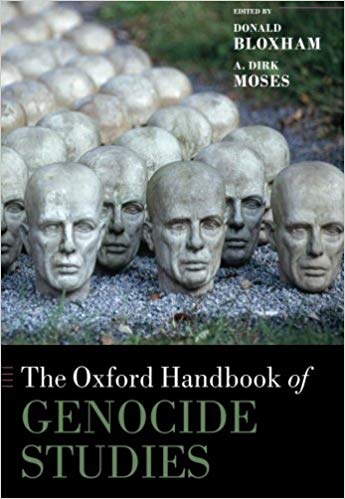Polokaust as Significant as Holocaust According to Genocide Scholars Lemkin and Bloxham

The Oxford Handbook of Genocide Studies, by Donald Bloxham (ed.) 2013
The Original Definition of Genocide (Raphael Lemkin) Recognized the Equality of Genocides of Poles and Jews–the “Universal Targeting” of Jews Notwithstanding. HOLODOMOR Was Genocide
This book presents thought-provoking information. For example:
HOLOCAUST SUPREMACISM, BY ITS VERY NATURE, DIMINISHES ALL THE GENOCIDES OF NON-JEWS
Donald Bloxham and A. Dirk Moses write, “On one side of the ledger, the notion of the Holocaust’s ‘uniqueness’, based usually on the totality of the Nazis’ murdered intent towards Jews, HAS WORKED TO DISTINGUISH IT FROM THE REST OF THE FIELD—with a number of distorting effects. If the Holocaust is taken as an ‘ideal type’ genocide…” (p. 4; Emphasis added).
Holocaust supremacism creates an artificial meritocracy where the Holocaust is the King of the Genocides, and a few also-ran genocides are sometimes mentioned alongside the Holocaust, with the remaining genocides all but forgotten. Bloxham and Moses recognize as much, “Then there is the tendency in university syllabi, textbooks, and the mantras of public commemoration of genocide to focus upon a few instances of genocide that, for a variety of reasons, have qualified for the canon of general acceptance: ALONGSIDE THE HOLOCAUST, Armenia, Cambodia, Rwanda, and the former Yugoslavia, and now Darfur tend to be included, but virtually no other cases. (p. 4. Emphasis added).
RAPHAEL LEMKIN, WHO COINED THE TERM GENOCIDE, JUXTAPOSED JEWS AND POLES AS VICTIMS OF GENOCIDE
For background information, please read my review of Raphael Lemkin’s classic, AXIS RULE IN OCCUPIED EUROPE.
Author A. Dirk Moses corrects various misconceptions about Lemkin, such as the demonstrably-false premise that Lemkin’s concept of genocide was based on a lack of awareness of the German murder of millions of Jews. Fact is, Lemkin knew about what came to be known as the Jews’ Holocaust. (p. 35).
Unlike too many Jewish intellectuals today, the Polish Jew Raphael Lemkin appreciated the sufferings of Poles as well as Jews, and unambiguously treated the genocides of both with equal esteem. A. Dirk Moses comments, “His Jewish identity was not structured like a zero sum game. He always mentioned the genocidal persecution of the Jews by the Nazis in the same breath as the mass murder of Polish Christians, Roma, and other victims.” (p. 24).
WHY RAPHAEL LEMKIN DID NOT ACCEPT THE “TOTALITY OF JEWISH DESTRUCTION” AS A VALID REASON FOR ELEVATING IT OVER “ONLY” THE PARTIAL ANNIHILATION OF THE POLES
A. Dirk Moses, in his analysis of Lemkin, comments, “Why did he not distinguish the Jewish case from that of other victims of the Germans? Because he thought the various techniques of genocide issues in the same catastrophic end: the destruction of nationhood or group culture, one way or the other. EVEN IF THE POLES WERE NOT TOTALLY EXTERMINATED, POLISH CULTURE WOULD BE, AND THAT FACT REPRESENTED AS GRAVE A LOSS TO HUMANITY AS THE LOSS OF JEWISH CULTURE. That is what Lemkin meant by genocide.” (p. 36; Emphasis added).
In other words, and using modern parlance, the Holocaust was no more significant than the Polokaust, and the Polokaust was no less significant than the Holocaust!
AT THE NUREMBERG TRIALS, THE NAZI GENOCIDE OF POLES WAS RECOGNIZED ON THE SAME FOOTING AS THE NAZI GENOCIDE OF JEWS
Author William A. Schabas examines the legal aspects of genocide. He tells how Justice Robert Jackson outlined the evidence that was about to presented at the Nuremberg Trials, “The indictment of the International Military Tribunal charged the Nazi defendants with ‘deliberate and systematic genocide’, viz., the extermination of racial and national groups, against the civilian populations of certain occupied territories in order to destroy particular races and classes of people, and national, racial or religious groups, particularly Jews, Poles, and Gypsies. The term ‘genocide’ was also used on several occasions the prosecutors during the trial itself.” (p. 125).
HOLODOMOR WAS NOT SOME SORT OF GENERIC GOVERNMENT-INDUCED FAMINE. IT WAS GENOCIDE
Although the Holodomor began as a famine that affected various parts of the Soviet Union, Stalin intentionally made it focused especially on Ukraine beginning about August 1932. (p. 397). Author Nicolas Werth identifies, in his words, Vyacheslav Molotov and Lazar Kaganovich, as Stalin’s “two closest collaborators” in this regard. (p. 397). (This attests to Jewish complicity in the Holodomor).
Joseph Stalin increasingly singled out Ukrainians not only as foes of the kolkhoz, but as enemies of the Soviet Union. (pp. 397-398). Thus, Ukrainian peasants were targeted not just because they resisted collectivization, but also because they were the core of Ukrainian national resistance to the Soviet system. (p. 398). So the destruction of the Ukrainian peasantry was largely synonymous with the destruction of the Ukrainian nation. And that is genocide.
To see a series of truncated reviews in a Category click on that Category:
- All reviews
- Anti-Christian Tendencies
- Anti-Polish Trends
- Censorship on Poles and Jews
- Communization of Poland
- Cultural Marxism
- German Guilt Dilution
- Holocaust Industry
- Interwar Polish-Jewish Relations
- Jewish Collaboration
- Jewish Economic Dominance
- Jews Antagonize Poland
- Jews Not Faultless
- Jews' Holocaust Dominates
- Jews' Holocaust Non-Special
- Nazi Crimes and Communist Crimes Were Equal
- Opinion-Forming Anti-Polonism
- Pogrom Mongering
- Poland in World War II
- Polish Jew-Rescue Ingratitude
- Polish Nationalism
- Polish Non-Complicity
- Polish-Ukrainian Relations
- Polokaust
- Premodern Poland
- Recent Polish-Jewish Relations
- The Decadent West
- The Jew as Other
- Understanding Nazi Germany
- Why Jews a "Problem"
- Zydokomuna